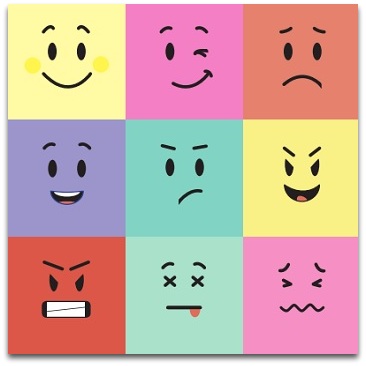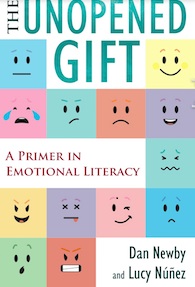Emotional Literacy 1, 2, 3
Coach and mentor Dan Newby specialises in emotional literacy and in today’s guest post he discusses a specific coaching conversation and shares some of his knowledge.
Emotional Literacy 1, 2, 3
By Dan Newby

“The thing I’d most like to change about myself is my impatience. I don’t like being so impatient but I’ve always been this way”. Those were the words a coachee said to me a few years ago as an explanation for why she wanted coaching. When I heard her I was puzzled because I didn’t have the impression she was especially impatient. She seemed confused when I asked her how she knew that what she was feeling was impatience but told me that is what her parents always called it.
Next, she told me the context that went with their statement. She was the oldest of 4 or 5 children, outgoing, energetic, curious and when she would suggest an activity more than once to her parents their answer was to tell her to “stop being so impatient”. When I asked her if the energy she was feeling and labeling impatience might be some other emotion she came up with several: Excitement, enthusiasm, anticipation, exuberance, joy.
As she considered the meaning of each emotion and the way it felt she realized that although she did experience impatience a small percentage of the time mostly she was experiencing one of the other emotions. For her this made an enormous difference. For almost 40 years she had been calling several different emotions by one name. By doing that she could not differentiate and appreciate the other emotions. Furthermore, her interpretation of impatience was negative and so her self-image had suffered. Once she embraced that she was experiencing enthusiasm, exuberance and joy her self-image shifted considerably.
If you reflect on that scene you’ll realize that we learn many things in this way, through things our parents say, and emotions are one of them. But what if the name your parents are using for an emotion is inaccurate? What if you heard and learned something they weren’t trying to teach you? This type of coaching situation is why I find Emotional Literacy so valuable. If we understand that each emotion is offering us unique information and has a purpose we can begin to befriend and rely on them. We explore them non-judgmentally. If we know that we have a choice between reacting and responding when we feel an emotion they become effective tools.
So where do we start with Emotional Literacy?
Curiously, if you look for a universal definition of what an emotion is you won’t find it. If you look for a single comprehensive list of emotions you won’t find that either. So, to use emotions in this way we need a new understanding of what they are and have the ability to explain them to our coachees. Emotions, for me, are simply “the energy that moves us”. If you think about the “feelings” your body experiences you will notice that each moves you in a different way. The energy of laziness prompts you to rest on the sofa or go to the beach to lay in the sand while the energy of ambition focuses you on taking advantage of possibilities. Jealousy moves you to protect or hold on to someone you care about while joy urges you to celebrate. Although there is no universal list of emotions I work with about 250. This is an enormous range considering that most of us can only identify and articulate 10 or 15.
Emotions each have a unique message or information for us as well. Sadness tells us “we’ve lost something we care about” while envy tells us “we’d like to have something someone else has”. Anger tells us what is unjust and trust tells us we are not taking excessive risk interacting with someone. We can deconstruct every emotion into three parts: 1. The story or information it is offering us, 2. The impulse or reaction and 3. Its purpose or the reason it exists. After 18 years of coaching I find emotions to be one of the most useful and quickest ways to work with coachees.
What are the steps to Emotional Literacy?
To get started there are 3: 1) Listening non-judgmentally to your emotions which, of course, requires you noticing them first, 2) Reflecting on what those emotions are trying to communicate or inform you of and 3) Articulating the story, impulse and purpose of the emotions. Later you’ll be able to connect or group various emotions but the first and most fundamental step is beginning to identify, name and articulate them.
1) Listening: One thing you may notice when you begin listening to your emotions is that you have assessments or judgments about them. Fear, anger and jealous are “bad” emotions while loyalty, love and compassion are “good” emotions. This is not a very helpful way to think about emotions because we generally try to avoid the “bad” ones and experience more of the “good” ones. In this interpretation “emotions are just emotions”. Each one can help us or can get in our way. Without fear we would not survive because we wouldn’t recognize danger but it can also immobilize us so that we are unable to act. So, learning to listen non-judgmentally to the emotions you are experiencing is an important first step.
2) Reflecting: It isn’t always immediately apparent to us why we are feeling the emotion we are. Reflection can help us consider what message the emotion is trying to deliver. Emotions trigger reactions – fear to run away, loyalty to defend, etc. – but that isn’t always the most beneficial thing we can do. Learning to choose our response can sometimes be more effective in the long run. This requires reflection.
3) Articulating: Earlier I said that there are not universal definitions for emotions. This means that they are interpretations and the way I explain love, doubt or envy will be different than the way you do. What is most important is that we have our own clear articulation and that we agree on the interpretation we use in our conversations. When we are coaching, it is vital that the coach and coachee share the same understanding of the emotion they are working with otherwise they are not talking about the same thing.
Once you, the coach, have begun to build your own emotional literacy you can offer it to your coachees. You don’t need to have clarity on all 250 emotions to begin working with them. If you have 10 you are clear on you can begin with those and build your vocabulary from there. Even those 10 are likely to give you a greater range than most of your coachees.
Since emotions are “the energy that move us” they are at the heart and foundation of everything we do and every choice we make. If we want to help our coachees see new possibilities and choose different actions they are a logical place to start.
To take a step forward sign up for a Free Introductory Course on Emotional Literacy at www.studyemotions.com. I welcome your insights, learning and feedback.
About Dan Newby
 Dan Newby trains and mentors coaches, works with organizations to elevate their emotional literacy, facilitates emotions workshops and is co -author of “The Unopened Gift: A Primer in Emotional Literacy” available on Amazon and Kindle. He lives near Barcelona, Spain and work worldwide with individuals and organizations. He offers on-line training courses in Coaching & Emotions through www.studyemotions.com. If you’d like to contact him directly his email address is dn****@***********ns.com.
Dan Newby trains and mentors coaches, works with organizations to elevate their emotional literacy, facilitates emotions workshops and is co -author of “The Unopened Gift: A Primer in Emotional Literacy” available on Amazon and Kindle. He lives near Barcelona, Spain and work worldwide with individuals and organizations. He offers on-line training courses in Coaching & Emotions through www.studyemotions.com. If you’d like to contact him directly his email address is dn****@***********ns.com.